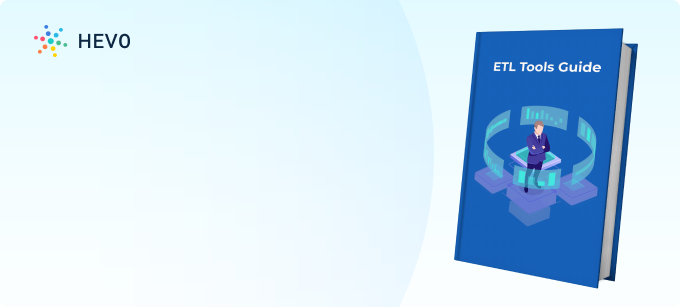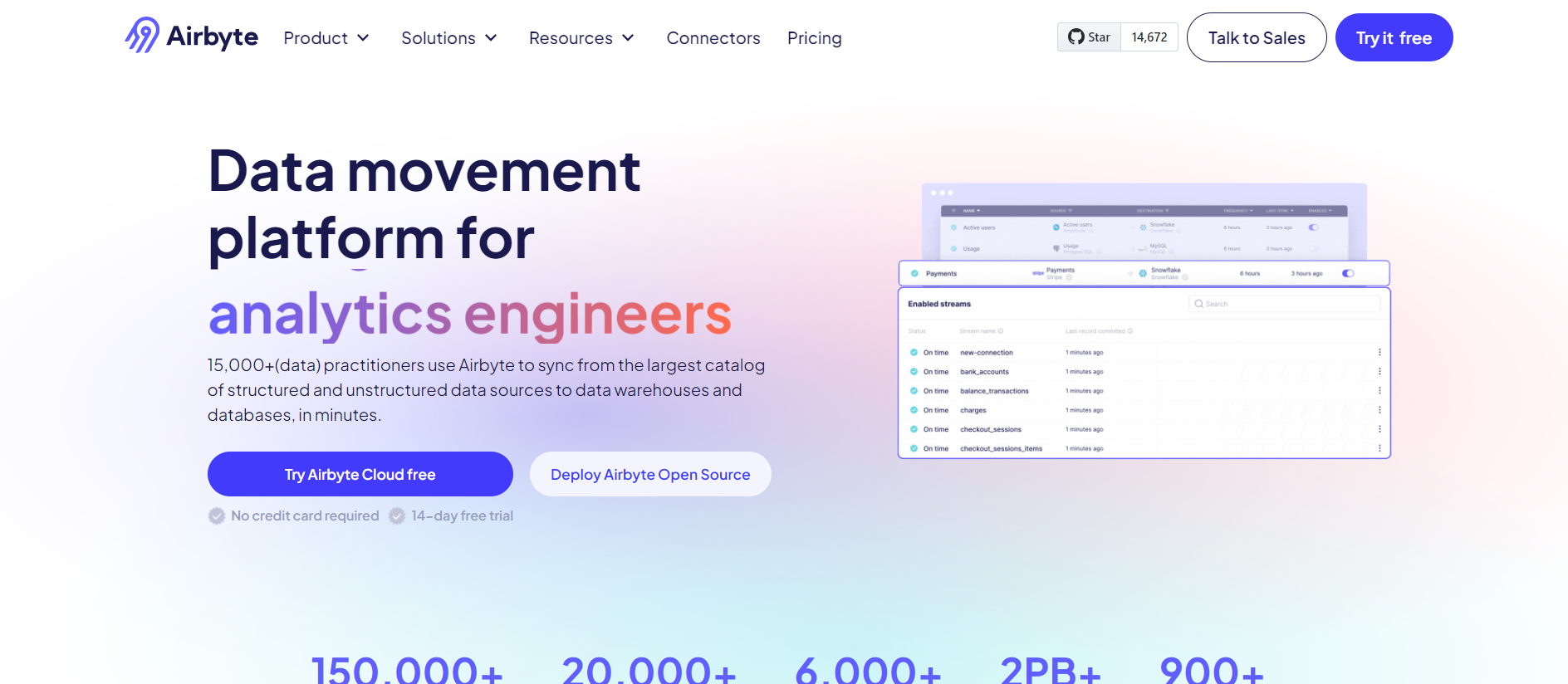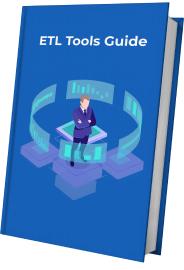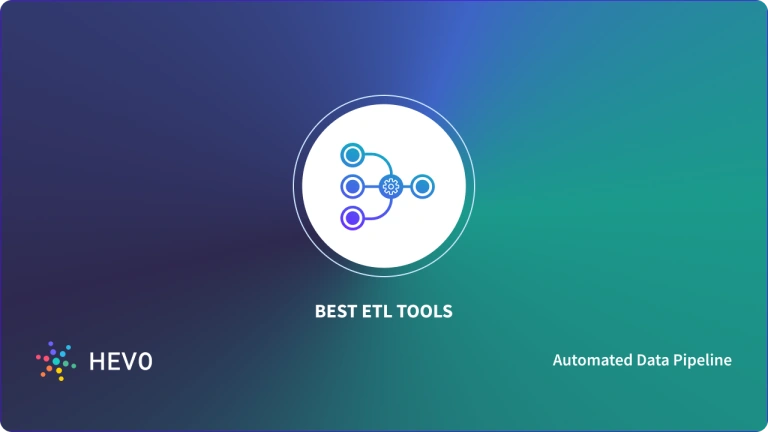To choose a good ETL tool that supports MongoDB, you must consider many factors such as sources, transformations, ease of use, monitoring, etc. ETL (Extract, Transform, and Load) is a process by which data is collected from various sources with the help of ETL tools, transformed into the required formats, and loaded into a database or data warehouse.
In this article, you will see a list of popular MongoDB ETL tools.
Table of Contents
What is ETL?
ETL is a data integration process divided into three steps: Extract, Transform, and Load. It integrates data from multiple sources and loads it in a centralized location, typically a Data Warehouse, for analytical purposes.
MongoDB – A Brief Introduction
MongoDB is a document database where every record is stored as a document. Compared to JSON Objects, MongoDB documents are pretty similar. A MongoDB document is nothing but a data structure in the form of key-value pairs. It is a NoSQL database, and it is entirely free.
MongoDB is highly popular for its incredible performance and scalability. It offers various features, including ad-hoc queries, indexing, replication, and load balancing.
Categories of ETL Tools for MongoDB
ETL for MongoDB is crucial in managing and integrating data from various sources. It performs operations like extracting data from MongoDB, transforming it, and loading it into another data storage or processing system.
Like other data management solutions, MongoDB uses various ETL tools.
- Cloud-based SaaS is available through a monthly subscription model.
- On-premises software solutions.
- PaaS (Platform as a Service) is an ETL tool offering comprehensive data integration services for MongoDB.
Cloud-based PaaS and SaaS are the most frequently used options due to their scalable pricing models and the ability to manage resources off-premises.
Hevo is one of the best ETL tools for MongoDB, providing a seamless and efficient way to extract, transform, and load data from MongoDB to various destination databases/warehouses. It simplifies the entire data pipeline process, ensuring that your data is ready for analysis and reporting.
Here is how Hevo can be of help:
- No-Code ETL: Set up ETL pipelines for MongoDB without writing any code, making it accessible to users of all skill levels.
- Real-time Data Sync: Continuously sync MongoDB data to your target destination in real time, ensuring up-to-date insights.
- Automated Schema Detection: Automatically detects and adapts to schema changes in MongoDB, reducing manual effort.
- In-Transit Data Transformation: Customize and transform your MongoDB data on-the-fly to meet your destination’s requirements.
Hevo stands out as a top choice for ETL, providing a powerful, user-friendly platform that automates and streamlines the data pipeline, enabling businesses to unlock the full potential of their MongoDB data.
Try Hevo as a MongoDB ETL Tool for FreeHow to Choose a MongoDB ETL Tool?
Several open-source ETL tools for MongoDB integration offer flexibility and customization options. When it comes to choosing the best ETL tool that suits your requirements, you need to consider various aspects as outlined below:
1. Setup
One of the important aspects that you need to consider while choosing a MongoDB ETL tool is how easy and simple it is to set up in your environment. You also need to know the prerequisites you need to install the ETL tool in your system. Some of the general prerequisites for ETL tools like MongoSyphon include having:
- MongoDB configured on Port 27017 with read/write permissions
- MySQL configured on Port 3306 with read/write permissions
- Have both MySQL and MongoDB client applications installed on the same path
2. Complete Monitoring & Management
The next important factor to consider is whether the tool provides features to monitor the ETL process effectively. It needs to have options to create rules for different activities, and every such action needs to be recorded in the database for further analysis. Overall, monitoring the ETL process needs to be made available, and users must be enabled to take reports on various crucial data sets.
3. Multiple Data Sources
Another aspect that needs to be considered while choosing the best tool is that it needs to support the extraction of data from various sources. You don’t need to be stuck with a tool that only comes with limited options in terms of data extraction.
When it comes to data warehousing, you cannot rely on only one data source. Hence, the tool you select for MongoDB needs to be able to work with multiple data sources and connect with various queuing products.
4. Ease of Use
The tool you choose must be easy to understand and use in a quick time. You can’t spend weeks understanding the working and features of the tool. Everything needs to be documented to enable you to understand it quickly so you can start setting up the tool and generate reports in no time.
5. Robust Data Transformation
With companies starting to use the cloud to store their data platform, it is crucial to look for a tool that provides options for a robust data transformation feature after the data is loaded into the database. There are various modeling tools available, like Talend and Data Fabric, or you can use just SQL.
6. Real-Time Data Streaming
We have moved into the age of Big Data, and we can see organizations moving vast amounts of data regularly. But still, sometimes, you need continuous or real-time streaming to get some actionable insights on the data. If you have such requirements, you must look for a tool that supports real-time data streaming.
7. Other Features
Other essential features that you need to look for while choosing an ETL tool that suits your data extraction, transformation, and loading requirements are:
- Flexibility
- End-to-end reliability
- Handle out-of-order data
- Extensive reporting
- Ability to integrate with various data cleansing tools
- Support for scheduling FTP sessions
- Support for OLE DB and OLAP metadata standards
- Learning curve – suitability for beginners
- Stability
- Number of Integrations
The Best MongoDB ETL Tools
This section reviews the best tools for setting up ETL in MongoDB in detail, including their prominent features, pricing, and use cases.
1. Hevo Data

Hevo’s Data Pipeline Platform helps to integrate data from over 150+ Data sources in a matter of minutes. Hevo is the only real-time ELT No-code Data Pipeline platform that cost-effectively automates flexible data pipelines to your needs. Billions of data events from sources as varied as SaaS apps, Databases, File Storage, and Streaming sources can be replicated in near real-time with Hevo’s fault-tolerant architecture.
Check out what makes Hevo amazing:
- Reliability at Scale – With Hevo, you get a world-class fault-tolerant architecture that scales with zero data loss and low latency.
- Monitoring and Observability – Monitor pipeline health with intuitive dashboards that reveal every stat of pipeline and data flow. Bring real-time visibility into your ELT with Alerts and Activity Logs.
- Auto-Schema Management – Correcting improper schema after the data is loaded into your warehouse is challenging. Hevo automatically maps source schema with destination warehouse so that you don’t face the pain of schema errors.
- Incremental Data Load: Hevo allows the transfer of data that has been modified in real-time. This ensures efficient utilization of bandwidth on both ends.
All of this combined with Hevo’s pricing and 24×7 support makes us the most loved data pipeline software on review sites.
Pricing
Take our 14-day free trial to experience a better way to manage data pipelines.
Sign Up or a 14-day free trial
Pros
- User-friendly Design
- Change Data Capture
- Reverse ETL
- Plug-and-play Connectors
2. MongoSyphon
When it comes to choosing a MongoDB ETL tool, you cannot miss out on MongoSyphon. It is a specially designed ETL tool to transform data into Mongo document structure. It can read and extract data from RDBMS tables, convert into JSON documents, XML output, or write directly onto the MongoDB.
MongoSyphon does its data join works internally in case the underlying database doesn’t provide any support or in a situation where it needs to merge data from various sources.
Once the extraction and transformation jobs are completed, MongoSyphon loads the data into MongoDB using native document upload methods. This is the main difference between MongoSyphon and other tools, as they are mainly designed to work with relational structures. But with MongoDB, it can either be used for bulk conversion or even for scheduled updates as well.
Even though there is no specific CDC (Change Data Capture) features available in MongoSyphon, it can accomplish it using SQL queries or utilize change tables to capture changed data from external CDC.
Key Features
- Native document upload
- Data Extraction
- Easy Data joins
- Basic CDC
- Supports various data sources
Pricing
MongoSyphon is open source and completely available for free.
Pros
- Enhanced performance levels with high speed and greater availability
- Simplicity in usage and quick setup in various environments
- Flexibility, particularly with features like sharding and scalability
Cons
- MongoSyphon has no GUI. So you need to know SQL very well.
- Since it is an early stage tool, it is not well tested enough.
- It has limited error handling.
3. Transporter
Next in our list of the best tools for MongoDB is Transporter, an open-source tool developed by Compose. It helps in extracting data from various data sources using adaptors. For MongoDB, the adaptor provided by Transporter comes with dual functionality as it can either read or write to a MongoDB database. The adaptors work by converting the data extracted into JSON documents and data transfer admins can easily work with the data during the data transfer process.
Transporter comes with abilities to allow users to configure multiple adaptors to various data sources including databases, excel sheets, files, and other types of sources.
Key Features
- Resume data process
- Robust data transformation
- Track changes
- Synchronize data sources during the data process
- Supports multiple data sources
Pricing
Transporter is open-source and is completely free.

4. Krawler
Krawler is another open-source ETL tool available for MongoDB created and maintained by Kalisio. The main purpose behind Krawler is to allow people to connect to sources containing geospatial and geographic content, extract them and convert into a format suitable for loading into MongoDB.
One of the important features of Krawler is that the time taken to extract data from geospatial data sources is very much less compared to other tools. Krawler only supports data sources supported by MongoDB, hence it is one of the highly recommended tools for ETL process. It also comes with detailed documentation to help the user understand the ETL process quickly.
Key Features
- Support for MongoDB data source
- Reduced time for data extraction and analysis
- Detailed documentation
- Minimalist ETL
- Open-source
Pricing
Krawler is open-source and is completely free.
Pros
- A minimalist ETL tool that automates the process of extracting and processing data
- Open and extensible to take benefits of the existing functions and add your own operations to them.
- Web orientation becomes easy
5. Panoply
Panoply is rated highly amongst the best paid ETL tools in the market. When compared to other tools, Panoply is a bit unique as it not only provides a platform to run your MongoDB ETL processes but also provides a cloud data warehouse too. Hence, you have a wide range of options for importing data not only from MongoDB but also from various other data sources. Another highlight of using Panoply is that you don’t need to define the schema of the data warehouse before the data extraction process.
Key Features
- Easy to use
- Quick set up
- All-in-one management
- Ideally suited tool for data analysts
- Supports a variety of data sources
- Ability to connect to BI tools
Pricing
Panoply is a commercial MongoDB ETL tool and the pricing ranges from $200 – $995.
Pros
- Easy to use platform
- Time-saving on data engineering
- Flexibility in connection with multiple data sources
Cons
- Difficulties with integrations
- Slow support response time
- High pricing


6. SYNC
The next MongoDB ETL tool in our list is SYNC, an open-source tool that is specially designed to provide data migration between various data sources and MongoDB. Even though it is specifically tested with MySQL and Oracle, the developers of SYNC claim that this tool is capable of working with any SQL database.
SYNC comes included with a GUI interface that makes it quite easy for MongoDB ETL admins to map different data sources. Other highlights of this ETL tool includes that it sends out email notifications on data migration completion along with a detailed summary.
Key Features
- Support for most SQL databases
- Easy to create joins
- Email notifications
- Process summary report
- Open-source
- GUI interface
- Auto-restart
- Batch selection/insertion features
- Supports OpLog
- Failure notification
Pricing
SYNC is open-source.
Pros
- User-friendly interface
- Failure notification
- Detailed summary report
Cons
- Dedicated admin
7. Pentaho
Last, but not least, Pentaho is a MongoDB ETL tool provided by Hitachi, the Japanese multinational company. Hitachi Ventara provides ETL tools both as a free, open-source version as well as a paid version too. When compared to the paid version, the features will be considerably lesser in the free version. The Pentaho platform offers users a 30-day trial period to test the product. It can be either tested with a downloaded version or users can try the business analytics platform online itself without any download.
The platform promises to offer a one-stop solution for all your data analysis requirements and business analytics needs. Pentaho provides excellent support to MongoDB and has released a detailed manual with instructions on integrating Pentaho with your system. Businesses looking for IoT data analysis can go with Pentaho as it comes equipped with a lot of features in that area.
Key Features
- Data flow automation
- Seamless data management
- Enhanced data pipeline management
- Supports modern architectures
- Real-time data analysis
- Predictive modeling
Pricing
Pentaho offers a 30 day trial period to test the business analytics tool.
Pros
- Wide range of tools and features
- Excellent reporting tool
- Highly accessible data integration model
Cons
- Difficulties with Mondrian-based ROLAP
- Lack of support and guidance for WEKA
- Limited Data Visualization features
8. Stitch
Stitch is an open-source, cloud-first platform designed for the rapid movement of data. It functions as a powerful and robust ETL service. It links all your data sources like MySQL, MongoDB, Salesforce, Zendesk, etc, and replicates those data to a destination of your choice. The benefits of using stitch are you can create faster ETL pipelines, Multiple connectors are available, and it gives high-quality user support
Key features
- Integration with SaaS, non-relational and relational databases, and various data sources
- Includes built-in MongoDB integration, though its effectiveness may depend on the version
- Developer-friendly
- Intuitive point-and-click interface
Pricing
Scalable standard pricing at around $100 per month, limited to 5 users per account. Enterprise plans are only provided on a custom-made basis.
9. Fivetran

Fivetran is best suited for enterprises aiming to convert or replicate small amounts of data, facilitating informed, data-driven decision-making. In the majority of data transformation processes, Fivetran uses the best processing capabilities of your existing data warehouse, enabling real-time data updates.
Key Features
- Pricing based on consumption
- Focus on ELT with some ETL functionalities
- Incorporates a MongoDB connector
- Reporting and monitoring capabilities
Pricing
The trial period is free, followed by charges based on actual usage.
Pros
- Rapid creation of ETL pipelines
- Availability of numerous connectors
- Excellent user support quality
Cons
- Certain levels of security and data protection compliance assurances are exclusive to enterprise pricing.
- Resetting data pipelines in case of errors can be challenging
- Costs escalate as data integration requirements expand.
10. Airbyte

Airbyte, a standout in the ETL landscape, boasts a user-friendly interface and an impressive array of 350+ connectors. Its API and Terraform Provider add further convenience. Airbyte can be run locally, in a Docker container, or a self-hosted cloud environment. As a commercial open-source solution, it offers a fully managed standard and enterprise solution.
Key Features:
- 350+ connectors
- Stream-level control and visibility
- Great customer support.
- Scalable Pricing
- Real-time monitoring and notifications.
Pricing:
It offers various pricing models:
- Open Source- Free
- Cloud—It offers a free trial and charges $360/mo for a 30GB volume of data replicated per month.
- Team- Talk to the sales team for the pricing details
- Enterprise- Talk to the sales team for the pricing details
Pros:
- Open-Source
- Easy to Use
- Change Data Capture
- Multiple Connectors
Cons:
- Per-credit pricing is a little confusing
- Frequent updates may force users to install new versions often.
11. Matillion

Matillion is one of the best cloud-native ETL tools designed for the cloud. It can work seamlessly on all significant cloud-based data platforms, such as Snowflake, Amazon Redshift, Google BigQuery, Azure Synapse, and Delta Lake on Databricks. Matillion’s intuitive interface reduces maintenance and overhead costs by running all data jobs in the cloud.
Key Features:
- ELT/ETL and reverse ETL
- Dynamically scale with Matillion’s PipelineOS,
- High availability
- Multi-plane architecture
Pricing:
It provides three packages:
- Basic- $2.00/credit
- Advanced- $2.50/credit
- Enterprise- $2.70/credit
Pros:
- Graphical UI and a wide variety of pre-built connectors
- Faster data loading
- Low-maintenance
Cons:
- Difficult to use
- Lacking two-way integrations
- Inefficient for high data volumes and complex transformations
12. Airflow

Apache Airflow is an open-source platform for managing complex data workflows. It was initially developed to meet Airbnb’s data infrastructure needs. Now, the Apache Software Foundation maintains it. Airflow is a popular tool for automating data engineering pipelines. It is widely used by data engineers, data scientists, and DevOps practitioners.
Key Features:
- Easy useability
- Numerous Integrations with platforms like Google Cloud, Amazon AWS, etc.
- Python for coding
- Airflow’s UI helps monitor and manage workflows.
- Highly Scalable
Pricing:
Free
Pros:
- A large number of hooks: extensibility and simple integrations
- Full REST API: easy access for third parties
- Open-source
- Integration with Cloud platforms like AWS, GCP, etc.
Cons:
- No versioning of workflows
- Challenging learning curve
- Requires coding/technical knowledge
- Debugging is time-consuming
Explore more about data integration tools and learn how they help streamline data movement across multiple sources and destinations.
Additional Resources on Mongodb ETL Tools
Conclusion
- There are various options available in the market when it comes to MongoDB ETL tools.
- Each has a specific set of features and related pros and cons.
- You can decide the best fit for your requirements by comparing these and finding the right fit.
When it comes to fully managed ETL, you can’t find a better alternative than Hevo. It is a No-code Data Pipeline product that will help you move data from multiple data sources to your destination. It is extremely easy to set up, as you can get the tool up and running in just a few minutes.
FAQ on MongoDB ETL Tools
1. What tools are used for MongoDB?
MongoDB Compass, MongoDB Atlas, Studio 3T, etc, are a few tools used for MongoDB.
2. Is MongoDB suitable for data warehouses?
MongoDB is not well-suited to a traditional data warehouse. Still, the MongoDB data platform sometimes provides enough support for analytics that a data warehouse or a data lake is optional.
3. Which data can you extract from MongoDb?
MongoDB provides access to many data types, including Documents, Collections, Indexes, GridFS, Aggregation, Transactions, Change streams, and others.
What is your preferred MongoDB ETL tool? Let us know in the comments section below.












